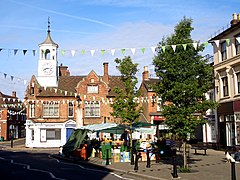Ampthill, Bedfordshire
| Ampthill | |
|---|---|
 Ampthill town centre with clock tower (1852) and market place |
|
| Ampthill shown within Bedfordshire | |
| Population | 6,769 7,028 (2011 Census) |
| OS grid reference | TL035375 |
| • London | 40 mi (64 km) SE |
| Civil parish |
|
| Unitary authority | |
| Ceremonial county | |
| Region | |
| Country | England |
| Sovereign state | United Kingdom |
| Post town | BEDFORD |
| Postcode district | MK45 |
| Dialling code | 01525 |
| Police | Bedfordshire |
| Fire | Bedfordshire and Luton |
| Ambulance | East of England |
| EU Parliament | East of England |
| UK Parliament | |
Ampthill is a small town and civil parish in Bedfordshire, England, between Bedford and Luton, with a population of about 7,000. It is administered by Central Bedfordshire Council. A regular market has taken place on Thursdays for centuries.
The name 'Ampthill' is of Anglo-Saxon origin. The first settlement was called 'Aemethyll', which literally means either 'ant-heap' or 'ant infested hill'. In the Domesday Book, Ampthill is referred to as 'Ammetelle', with the landholder in 1086 being Nigel de la Vast. The actual entry reads: Ammetelle: Nigel de la Vast from Nigel d'Aubigny. A further variation may be 'Hampthull', in 1381.
In 1242, King Henry III confirmed the right to hold a market on Thursdays. These continue more than 750 years later.
Henry VIII was a frequent visitor to Ampthill Castle, and it was there that Catherine of Aragon lived from 1531 until divorced in 1533, when she was moved to Kimbolton. The castle was built in the 15C by Sir John Cornwall, later Lord Fanhope, from ransoms after the Battle of Agincourt. Although the Castle is now gone, some intriguing indications of castle life remain- such as the local ponds (Westminster pond being one) allegedly built to supply the castle with regular supplies of fish.
In the mid-1780s, John Fitzpatrick, the 2nd Earl of Upper Ossory, led a campaign to improve the town centre. He created the current market place, erected the water pump and built a new clock tower. Lord Upper Ossory was also responsible for a cross commemorating Catherine of Aragon, with an inscription by Horace Walpole, and a row of thatched cottages built between 1812 and 1816 to house his estate workers.
...
Wikipedia

